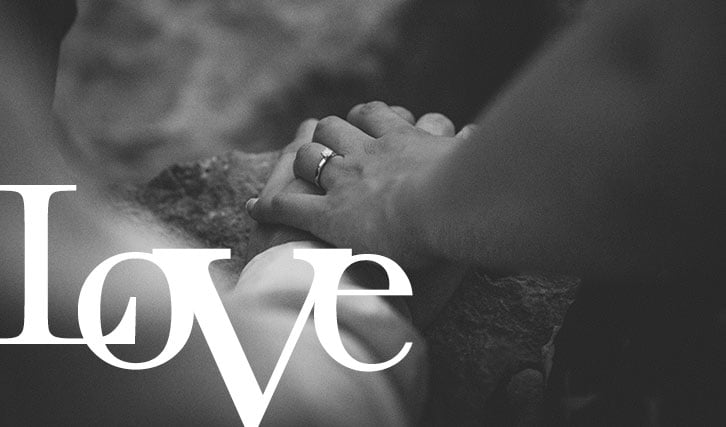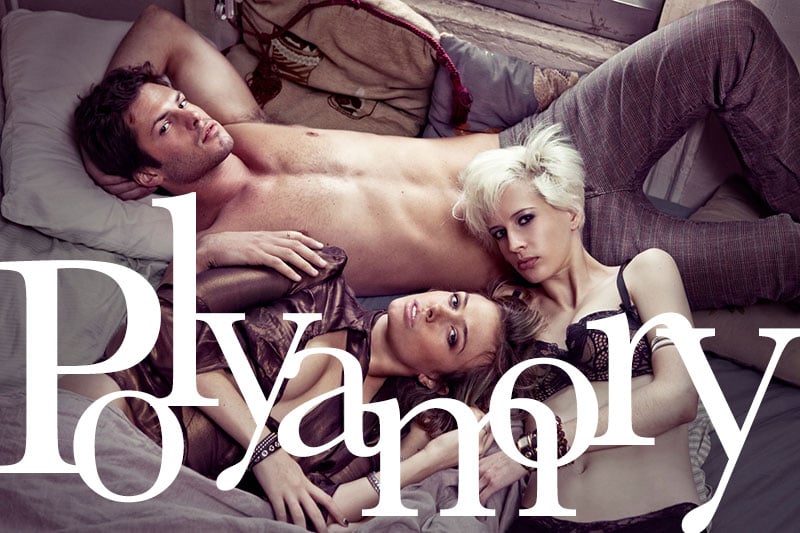Polyamory is getting a lot of airtime in the media lately.
Five years ago, you could say “polyamory” in an average room full of people and get nothing but blank looks in return. (Believe me, I did. Many times.) A decade ago, this was even truer. But, having been featured in mainstream media as diverse as a New York Times article, a documentary by Louis Theroux and even a parody piece in The Onion, polyamory is, slowly but surely, becoming mainstream.
For those of us who have been living this life for a long time, increased mainstream attention is a mixed bag. It’s a great blessing, of course, to not have to explain what polyamory is to every single person we choose to come out to for the rest of forever. Though they may have some weird preconceptions (they probably do,) more people now have at least a vague idea of what it’s all about. On the other hand, when something is in the media, people talk about it—and they can say things which sting, even if hurting you isn’t their intention. I felt upset and judged after hearing a colleague, who had watched the Louis Theroux documentary, talk about how “gross” and “weird” polyamory was. The person in question didn’t know—I’m not out at work—that there was someone sitting three feet from them who was personally affected by these words. But the judgement served to shove me further into the closet, even so.
Let’s back up a bit—what’s this “polyamory” thing all about?
Polyamory—a portmanteau of the Greek poly, meaning “many,” and the Latin amore, meaning “love,” – literally means “many loves” and is defined as the desire, practice or
acceptance of maintaining more than one emotionally and sexually intimate relationship concurrently, with the full knowledge and consent of everyone involved. It’s a specific subtype of relationship which falls under the umbrella of “consensual non-monogamy” (sometimes called “ethical non-monogamy,”) a family of relationship styles which also includes swinging, open relationship/marriage, “monogamish” dynamics, and any other relationship style which does not demand strict monogamy of the participants and in which everyone is aware of the arrangement.

What polyamory is not
Polyamory is not swinging: there’s nothing wrong with swinging! (I myself am a minority within a minority in relationship style terms, in that I identify as both polyamorous and a swinger). Unfortunately, there can be animosity between polyamorous folks and swingers—broadly, the two communities just don’t seem to like each other all that much! The difference between polyamory and swinging is that polyamory tends to focus on longer-term relationships with a romantic element, whereas swinging is more focused on recreational and casual sex while having only one romantic partner.
Polyamory is not polygyny. Polygamy, or more properly polygyny—literally “many women” – is the practice of a man having multiple wives while his female partners cannot have any other partners of their own. This is a deeply misogynistic, religiously-rooted practice and has no place in ethical polyamory. While not everyone in a polyamorous dynamic needs to always have multiple partners—my friend Livvy wrote a brilliant piece this week about being in a polyamorous relationship but choosing not to have any partners besides her husband — all partners need to have the same opportunity to do so, should they wish. Men who have multiple female partners without allowing these women to have other partners of their own are practising what is derisively called a “One Penis Policy” which, again, is a form of male entitlement and misogyny.
Polyamory is not cheating. “People say to me, “oh, you’re just legitimising cheating!” Laura told me. “But it’s not like that at all. Cheating is about lying—the betrayal is in the deception, in the breaking of agreed-upon boundaries.” By definition, polyamory is not cheating because polyamory requires honesty and informed consent.
How does it even work!?
It’s become a cliché to say it, but there are as many types of polyamorous relationships as there are people who practice them. There is no one-size-fits-all, and many polyamorous people are drawn to this love style because it enables them to build the relationship they want from the ground up. In their 2015 book of the same name, Mark Michaels and Patricia Johnson refer to “Designer Relationships” that is, relationships the participants can shape however they like.
“The great thing about polyamory is there’s no script,” Louisa told me. “Romantic relationships in our society come with a certain level of expectation attached—that you’ll be monogamous, that good relationships must lead to cohabitation, marriage and children, that it must be lifelong or else it has failed. Non-monogamy gives you permission to take a step back from that, and ask “what do I actually want?” Polyamory blogger and author Amy Gahran, who used to blog on solo polyamory at SoloPoly.net, refers to this set of assumptions as “the relationship escalator,” and her book Off The Relationship Escalator: Uncommon Love & Life explores ways in which we can find fulfilment in relationships by chasing what we actually want, instead of what society says is normal.
That’s great, but how does it work in practice?
Again: there are many ways polyamorous relationships can be structured, and many different factors will play a part: age, geographical location, ability or disability, sexual orientation, socio-economic class and whether or not you have children are just some of the things that are likely to play into a decision about which relationship style is best for you.

Let’s look at some of the most common, shall we?
Hierarchical polyamory:
In this type of arrangement, one relationship is “primary” (the most serious or most life-entangled relationship, often a spouse or the person you live with) and other relationships are “secondary” or “non-primary”. Hierarchical polyamory has fallen out of favour due to a number of people abusing the power that comes with being a primary partner, but I will defend it to the death as a valid structure—when done properly, it’s entirely possible to have a primary/secondary set-up that is functional, respectful and healthy for everyone involved. Primary partners in this type of dynamic will often make major life decisions together and may share finances or the raising of children. They may also make agreements about their relationships and how they want them to look, including deal-breakers (one such agreement in my own primary relationship is “we only want to live with each other, neither of us may invite another partner to move into our home”.)
Non-hierarchical polyamory:
In this type of situation, no one relationship is considered “primary”. People may or may not choose to live with a partner (or more than one partner!) but no relationship is considered more significant or more entangled than any other. Folks who practice this type of relationship tend to favour fewer rules and agreements in their relationships.
Kitchen table polyamory:
is really a sub-type of polyamory that can exist in hierarchical, non-hierarchical or solo-poly arrangements and just means that everyone involved gets along and enjoys spending time together socially. Literally, the name comes from the idea that you can all happily sit around the kitchen table together.
Solo polyamory:
Solo poly people value a high degree of autonomy and their own space. They generally do not wish to live with a romantic partner at all, and operate in the world as a “free agent”. “For me, solo polyamory is all about being my own primary partner,” Richard explained to me.
Relationship Anarchy:
sits at an extreme end of the “no rules” school of thought, and tends to boil down to “I can do whatever I want with whoever I want.” Many people who identify as Relationship Anarchists also reject the distinction between romantic partners and other types of significant and intimate connections such as deep friendships and reject the notion that the presence or lack of a sexual connection makes any relationship more important than any other.
Don’t Ask, Don’t Tell is a dynamic wherein a couple accept that they will have other relationships outside their primary dyad, but do not wish to hear anything about their partner’s activities or meet any of the people involved.
It’s not my job to tell you which style of non-monogamy is best for you if you’re considering entering the lifestyle. They all have their pros and cons and the models I’ve listed here are far from the only options available to you. Talk to your partner(s), voice your own needs, and come up with a system that works for you.
Who practices polyamory?
All kinds of people! There is an unfortunate misconception that polyamory was invented by Millennials and popularised by Gen Z-ers. However, this is simply untrue. There is evidence that consensual non-monogamy in some form has existed for the entirety of human history. For more information on this, I recommend you read the chapter on the history of polyamory in Dedeker Winston’s The Smart Girl’s Guide to Polyamory (2017.) The term polyamory was coined by Morning Glory Zell-Ravenheart in her 1990 essay “A Bouquet of Lovers” and grew out of an earlier term, “polyfidelity” (“faithful to many”) which was used by members of the Kerista commune as early as the 1970s.
Modern polyamory is an exceptionally diverse community, and the representation it gets does not always reflect this diversity. If you’ve read any article on polyamory on the internet, you’ve likely seen the stock photo of three pairs of (white) feet sticking out from under a white duvet. The reality, though, is so much more than that.
Polyamory and parenting
“But what about the children!?” people cry, clutching their pearls. I’m exaggerating, but only a little bit. I was once told that being polyamorous would someday be bad for my children (children I neither have nor want.) But polyamorous people do have and raise children, and balance the complexities of parenting with the complexities of a non-monogamous relationship structure.
Paul is a parent of three children under the age of 10, two with one of his partners and one with another. “Of course it’s complicated,” he told me. “But it’s an amazing blessing too. More adults mean more people to love and care for the children, more people to play with them or help with their homework or pick them up from school. It means if someone’s sick, there’s always someone who can step in to help with childcare. I don’t believe it’s confusing to them—they know exactly who their mum and dad are, and they know that these other adults are family and love them too. Our kids’ school know our situation and all our long-term partners are listed as responsible adults who they can call if they need to.”
Livvy is a mother of 5 month-old baby M. She explained how her new identity as a mother has tested her self-esteem and brought up insecurities she’d never dealt with before. “The deeper I fell into motherhood,” she explains, “and the more I love and enjoy it, the further apart I felt from that person who was so sexually confident. Standing among [my husband’s] other partners and feeling secure was effortless before; now at times of particular exhaustion or hormone fuckery, I struggled to see my place, only seeing where I was deficient and doubting my value for the first time.” Happily, she went on to explain that she and her husband are navigating this new normal with plenty of loving support and active communication.
On the flip side, what do the children of polyamorous parents think? Author, activist and sex educator Koe Creation grew up in a sex-positive, polyamorous family and their memoir, This Heart Holds Many (Thorntree Press, 2019) chronicles the things they learned and challenges the “polyamory is bad for children” narrative. In the promotional blurb for their book and tour, Koe writes, “I was blessed with a deeply caring tribe who taught me the power of self-awareness, compassionate communication and resilience.”
Polyamory and people of colour
Unfortunately, the portrayal of polyamory in the media and to the wider world is overwhelmingly white. As a result, people of colour often do not feel welcomed or included in polyamorous spaces, and many encounter overt racism in these environments. I recently interviewed Kevin Patterson, a black polyamory activist and author of the book Love’s Not Colour Blind: Race & Representation in Polyamorous and Other Alternative Communities (Thorntree Press, 2018.) In his book, Kevin explores the unique issues faced by people of colour in alternative sexuality communities, which include having their experiences erased, being fetishised, and being talked over by white folks. In our interview, Kevin explained, “the main issue is that people of colour aren’t going to have an identical experience to white people in these communities. It’s based on all of the societal influence that we can’t really escape.” Kevin’s blog Poly Role Models aims to highlight the true diversity of polyamory.
In her 2015 essay “There’s a Big Problem With Polyamory That No-One’s Talking About,” Kaitlyn Mitchell writes “People of colour, especially black polyamorists, report feeling “othered” and excluded in poly environments such as meet-ups, with women feeling especially at risk of being objectified and fetishized as an exotic sexual plaything.” Blogger “Polyam Gal Seeks” identifies as Chicanx and polyamorous. “I’m light-skinned so I often read as white or ambiguous,” she said, “but much like monogamous people of colour, I’ve been exoticised for my background—which is no fun! There’s this weird ‘gotta catch ‘em all’ vibe, where a white guy or a white couple wants to brag that they have a ‘girlfriend of every colour.”
Finn agrees. “As an aboriginal person, I feel like I’m seen as a trophy in polyamorous spaces—especially because, where I live in Australia, aboriginal issues are in Vogue right now. People give token support to gain social clout, or act like just being sexually or romantically involved with me is a form of activism.” Finn also spoke about how white people tend to offload their guilt onto them. “I’m frequently used as a sponge for white guilt,” they said. “They unload all their guilt about racism onto me under the guise of solidarity, which just leaves me feeling burdened and drained.”
It’s clear that us white folks have a lot of work still to do in making polyamorous spaces more welcoming to people of colour—and in supporting the creation of POC-led and POC- only spaces. “Personally,” Polyam Gal Seeks added, “I’d love the option at the start of an event to be able to meet with other POC polyamorous folks and get to know them better in a members-only space.”
Polyamory over 50
The narratives around polyamory we see in the media seem to mostly feature people in their 20s and very early 30s. However, this is far—far—from the whole story. There is a huge contingent of older polyamorous people, those in their 50s, 60s, 70s and beyond.
Sue is in her 50s and has been polyamorous for five years. “I have a Dominant who has other partners, but everyone knows about the others and I was fully aware of this situation from the outset. Most of us have had long term monogamous relationships at some stage of our lives and have realised this works better for us. One challenge, which is probably not unique to older polyamorous people but perhaps more likely, was when my partner became ill last year. I wanted to be there for him and support him, but I struggled more knowing there were other people involved—whereas this never bothered me from the sexual perspective. I think he also found it difficult due to the added pressure of having to keep everyone informed about what was going on.”
Sallyanne, an erotica author, is also in her 50s and identifies as solo-poly. “Ageism is a bit of an issue,” she told me. “Women who are older are sometimes seen as a bit ‘past it’ or not desirable, but this simply isn’t true. There are advantages, though—you might be at a stage in your career where you have to put fewer hours in, giving you more free time. Also, once you get past the menopause there is no more worrying about unwanted pregnancy! And, to be honest, once you get past about 40 and you have a history of being poly or kinky, you have so few fucks left to give about people’s negative opinion of you.”
Polyamory and disability
Pippin and Jos are primary partners who have been together for ten years. They each have other partners. They also both identify as physically disabled. I talked to them about the ways in which disability complicates the reality of living a polyamorous life, but also the ways in which it can be hugely beneficial.
“I could never do Relationship Anarchy, even if I were interested in it—which I am not,” Pippin explained. “Jos is my carer, and to an extent, I am also theirs. I cannot live alone, and I need a good deal of stability in my living arrangements. So having a primary partner, in a gentle and caring hierarchical structure, is necessary for me.” They also added that when looking for people to date, they need to find people who they trust with their wellbeing and to whom they can entrust some caring responsibilities. “They may need to push my wheelchair, for example, or be responsible enough to cope if I have a seizure.”
These complications aside, they also spoke about the ways in which polyamory has greatly enriched their lives. “Polyamory isn’t the only reason I have a large and strong support network, but it certainly helps!” Pippin told me. “I am often bedridden which can be isolating, and having a network of partners and kissing or flirting-friends means that I still get love and attention on days when I’m feeling awful.”
“Polyamory involves more potential or insecurity and anxiety, which intersects with one of my disabilities,” Jos added. “But choosing emotionally intelligent partners who know how to communicate largely solves this!” Pippin agrees: “we are both very patient with each other’s insecurities. In fact, I think things are in some ways easier for us because we’re both disabled—we both get it.”
As you can see, polyamory is so much more diverse—and complex, messy, joyful and customisable—than the “three pairs of white feed under a white duvet” polyamory of the mainstream media. What would you like to know about polyamory? Tweet us or ask in the comments—maybe we’ll run a follow-up piece to answer more of your questions…
Resources to learn more:
- morethantwo.com is the biggest polyamory resource on the web, but readers should be aware it is owned by Franklin Veaux who has recently been outed as having emotionally abused a number of his partners. There’s some good stuff on there despite Veaux’s actions, and the survivors have not asked for a boycott of Veaux’s work, but engage or not as you’re comfortable with.
- Polyamory Weekly podcast
- My monthly column on polyamory at thebigfling.com
- The Ethical Slut by Dossie Easton and Janet Hardy
- The Smart Girl’s Guide to Polyamory by Dedeker Winston
- Opening Up by Tristan Taormino
- Building Open Relationships by Dr Liz Powell
- Rewriting The Rules by Meg-John Barker
- Life on the Swingset podcast
Pseudonyms have been used throughout unless the participant wished to be identified by their real name.



